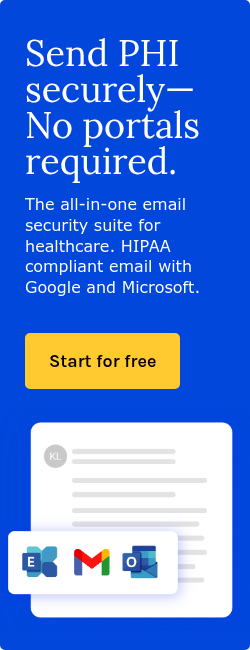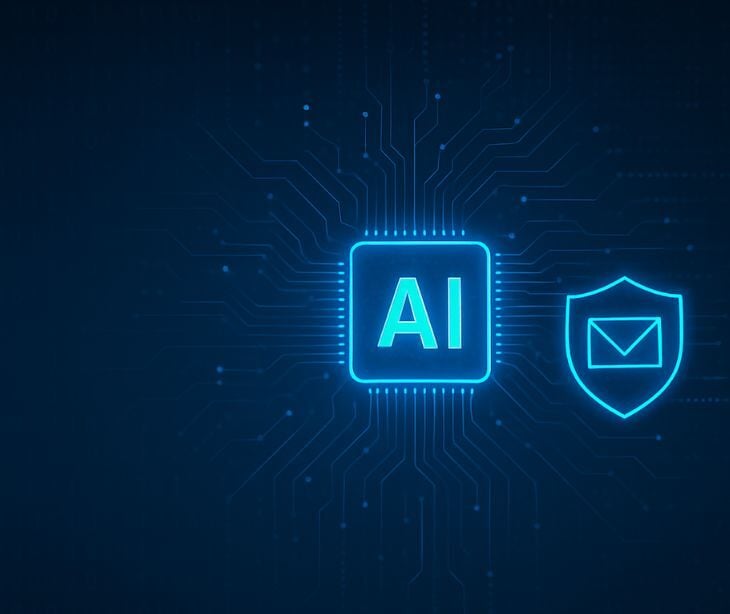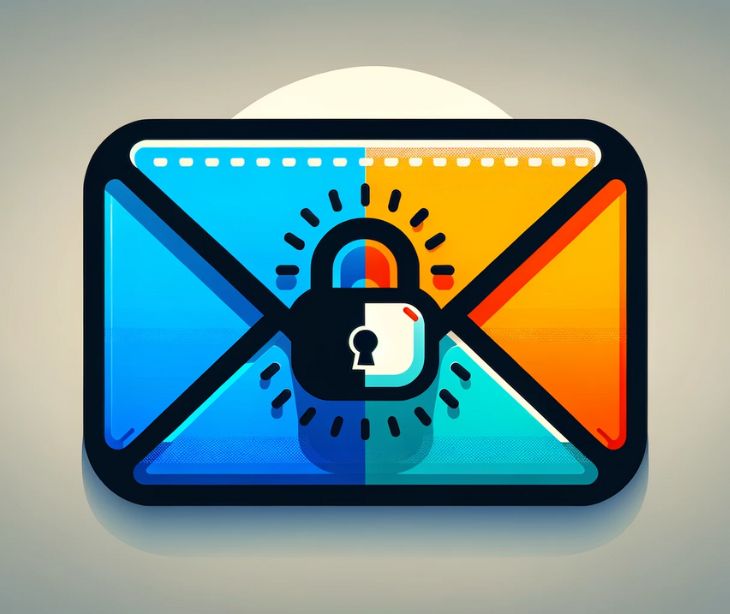
Healthcare organizations face an unprecedented volume of email-based attacks, with the FBI reporting billions in losses annually and Paubox data identifying over 180 significant healthcare breaches stemming from email security failures.
While understanding attack vectors like phishing, business email compromise (BEC), and account takeover (ATO) is helpful, grasping the complete spectrum of consequences when these attacks succeed is what truly drives effective defense strategies. The fallout from a successful email breach extends far beyond the initial compromise, creating a devastating cascade of effects that ripple throughout an organization and beyond.
Learn more: Understanding email threats targeting healthcare
Compromise and exposure of sensitive PHI
When attackers breach healthcare email systems, they gain access to a collection of protected health information (PHI), which is considered valuable according to research published in BMJ Health Care and Informatics. Through sophisticated phishing campaigns, cybercriminals gather credentials that unlock email accounts containing large amounts of sensitive data. Once inside, attackers can quietly forward emails to external accounts, download message archives, or set up auto-forwarding rules to continuously siphon confidential communications for weeks or months before detection.
A prime example of this threat occurred during the SolarWinds cyberattack, where state-sponsored hackers used stolen credentials to infiltrate high-profile email systems, including U.S. government agencies. After gaining access, the attackers established auto-forwarding rules, silently diverting sensitive communications – including PHI – to external accounts for months. The breach went undetected due to its stealthy nature, proving how compromised email systems can become a long-term data leakage channel. This incident shows the risk of phishing-based email breaches, where even delayed detection can lead to massive PHI exposure.
Email-delivered malware presents another severe threat, deploying keyloggers that capture credentials, ransomware that encrypts data, or backdoor trojans that provide persistent access for data exfiltration. These attacks typically target the most sensitive and valuable information: Social Security numbers, detailed medical diagnoses, treatment plans, insurance details, billing records, home addresses, and dates of birth – precisely the comprehensive data sets most valuable for identity theft and fraud. "Personal medical data is said to be more than ten times as valuable as credit card information," explains Laurie Zabel, Director of Coding and Compliance for MedSafe. "PHI has such a high value because it contains highly sensitive information, such as social security numbers, birth dates, addresses, credit card numbers, telephone numbers and medical conditions. This data is incredibly valuable on the black market because, unlike a stolen credit card that can be easily canceled, most people are unaware that their medical information has been stolen."
The scale of these breaches is staggering. A single compromised email account at a large healthcare system can expose records for tens or even hundreds of thousands of patients. Recent incidents have affected millions—like the Shields Health Care Group breach that compromised 2 million patient records or the Advocate Aurora Health incident impacting 3 million individuals. Unlike breaches in other industries, healthcare data exposure carries unique consequences due to the deeply personal nature of the information.
In one instance, a patient whose HPV status was publicly shared on Facebook struggled with trust issues and required therapy to address the trauma. In another case, an 11-year-old boy faced bullying after his suicide attempt was disclosed at school, potentially worsening his mental health challenges and creating additional barriers to treatment.
For affected patients, the impact is immediate and potentially life-altering. Beyond financial fraud and identity theft, patients face the distressing reality that strangers now possess their most intimate medical details. This violation creates significant anxiety and distress, eroding the trust between patients and healthcare providers at precisely the moment when individuals are most vulnerable. Research published in American Medical Informatics Association (AMIA) reveals that patients' willingness to trust healthcare providers is directly influenced by their perception of privacy protection measures and organizational commitment to confidentiality. The study demonstrates a clear correlation between provider transparency about data handling practices and patients' comfort in sharing sensitive health information.
Go deeper: The impact of HIPAA violations on patient care
Operational disruption and patient safety risks
Email attacks trigger operational disruptions that directly threaten patient safety, a consequence unique to healthcare breaches. When ransomware deployed via email encrypts critical systems, healthcare providers lose access to electronic health records (EHRs), medication administration systems, scheduling platforms, and diagnostic imaging. These are not mere inconveniences; they represent immediate threats to patient well-being.
Matt Murren, CEO of True North ITG, states, "We encountered a significant case where an outdated email system directly impacted patient care due to a cybersecurity breach... This vulnerability allowed attackers to compromise user credentials and eventually deploy ransomware across the network. The consequences were severe… The ransomware attack rendered the organization's systems inaccessible for nearly two weeks… During this time, the clinic operated at a fraction of its capacity. Scheduling, access to electronic health records (EHRs), and even communication between staff members were all severely hindered."
Denial of Service (DoS) attacks targeting email infrastructure can overwhelm servers, blocking the delivery of urgent clinical communications. Lab results, emergency consultations, patient appointment reminders, transfer coordination, and notifications from patient portals suddenly stop flowing. This communication breakdown fractures the continuity of care while creating dangerous information gaps.
According to an academic paper titled ‘Denial of service attacks – an updated perspective’, such attacks can "easily consume computing and communication resources of the victim or disrupt/clog availability of resources to the intended users within a short period of time."
Attackers often deploy DoS attacks as diversionary tactics, drawing IT resources away while simultaneously launching more damaging secondary attacks. This aligns with the paper’s findings showing that "extortionists" and "exfiltrators" use DoS attacks to "distract interest from their actual aim – stealing data for money in a form of intellectual property or credit card numbers." The article confirms that operational downtime is a significant consequence, noting that DoS attacks can result in "consumption of the victim's memory" and cause systems to become "unavailable to the intended users," creating precisely the kind of communication breakdown that endangers patient care.
Email-initiated attacks have led to:
- Delayed diagnosis when test results can't be communicated or accessed
- Postponed surgeries and canceled procedures that require rescheduling of high-risk patients
- Medication errors when prescription systems become inaccessible
- Diversion of emergency patients to distant facilities when local resources are compromised
- Exposure to physical harm when connected medical devices are affected by network breaches that begin via email
When frontline clinicians and technical teams are forced to shift focus from patient care to incident response, the impact worsens. Providers revert to inefficient paper processes, staff are reassigned to manual communication roles, and resources are diverted from their primary purpose of healing patients.
Crippling financial costs
The financial toll of email breaches in healthcare extends far beyond any initial ransom demands, creating a myriad of costs that can cripple organizations. According to IBM's Cost of a Data Breach Report, healthcare breaches now average $9.8 million per incident, the highest across all industries.
This financial burden manifests across multiple fronts:
- Incident response costs: Organizations must immediately engage forensic investigators, specialized technical consultants, and crisis management teams. These experts require high rates, particularly during active incidents, with costs easily reaching hundreds of thousands of dollars in the first days alone.
- Legal expenses: Healthcare providers must retain specialized counsel to navigate regulatory requirements, prepare for investigations, and defend against inevitable lawsuits. Legal fees often continue for years after the initial breach.
- Regulatory penalties: HIPAA violations resulting from email breaches trigger substantial penalties. The Solara Medical Supplies case demonstrates this reality, with the OCR imposing a $3 million settlement for HIPAA violations following a breach.
- Class action settlements: Patient litigation adds another layer of financial exposure. Continuing with the Solara example, beyond the regulatory penalty, the company agreed to a $9.76 million settlement to resolve the class action lawsuit brought by affected patients.
- Notification and remediation services: HIPAA's Breach Notification Rule mandates informing affected individuals. Organizations usually provide credit monitoring and identity theft protection services, adding $10-$30 per affected individual.
- Operational losses: Revenue ceases when systems are down—appointments are canceled, procedures postponed, and patients seek care elsewhere. These losses can exceed direct breach expenses.
- Insurance consequences: Following a significant breach, cyber liability insurance premiums invariably increase, if coverage remains available at all. Many policies now specifically exclude ransomware, leaving organizations to shoulder more costs directly.
For smaller healthcare providers or specialty practices with thin margins, these growing financial burdens can threaten their very existence. Even large health systems feel the significant impact of these unexpected, unbudgeted expenses that divert resources from patient care improvements and strategic initiatives.
Go deeper:
- Why small healthcare practices are at greater risk for cyberattacks
- What are the notification requirements after a breach?
FAQs
What are BEC attacks?
Sophisticated phishing scams that impersonate authorized personnel to trick employees into releasing funds or data.
What are ATO attacks?
Unauthorized access to email accounts, allowing attackers to steal data, impersonate users, and disrupt operations.
What are keyloggers?
Malware secretly recording keystrokes, capturing passwords, medical information, and other sensitive data.
What is the HIPAA Breach Notification Rule?
Requires covered entities to notify affected individuals and authorities of breaches of unsecured PHI within 60 days, with penalties for non-compliance.
Subscribe to Paubox Weekly
Every Friday we'll bring you the most important news from Paubox. Our aim is to make you smarter, faster.




